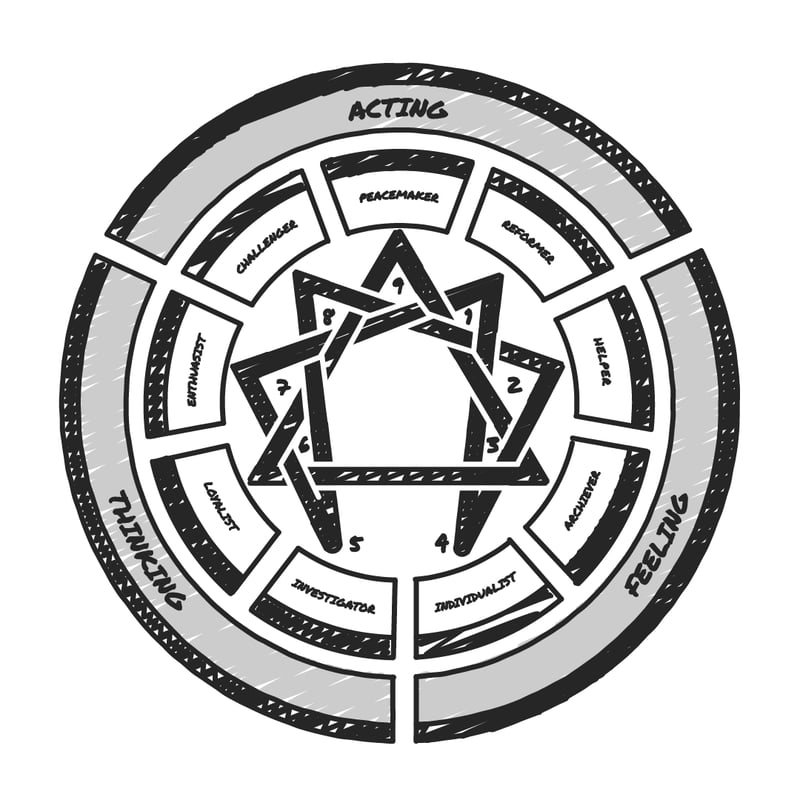The 9 Ways We Seek to Matter: Insights from the Enneagram
I deeply believe that one of the keys to being a successful leader is self and others awareness. We leverage a number of assessments, tools, and frameworks at Ninety to better understand what we believe are our innate preferences. Today, I want to go a little deeper into one of the frameworks we use to help us better understand what motivates us and those around us.
At the risk of stating the obvious, understanding some of the core aspects of what is generally referred to as “personality types” is vital in business. In fact, if you buy into my general theories on trust, you won't be surprised that at the core of our superpowers — strategic thinking, empathy, or creativity — are our innate preferences. These are the things we are really good at, and high-trust leaders are authentic and leverage their talents to matter.
We all reflect this in our own journey to discover meaning. For instance, we often chase different career paths and hobbies. We make everyday choices, all in the hope of feeling valued and connected. These decisions reflect our innermost desires and fears. As we grow up and look to others for guidance, we start to adopt their goals and ways of finding happiness, too.
This continuous process of self-discovery is crucial. As we learn to identify our interests, passions, and the early indicators of our unique strengths (aka talents and gifts), we shift away from the need for external validation and begin to recognize our own unique superpowers. This dynamic is particularly vital in business since these superpowers become the tools we use to lead others.
At Ninety, we leverage three tools to help us Work together. These tools include Kolbe, for helping us better understand our problem-solving preferences; TypeCoach (what we believe is the best of the best Meyers-Briggs tools/services in the whole world), for helping us communicate; and the PRINT® survey (developed by the Paul Hertz Group), which is a version of the Enneagram built specifically for the modern workplace. PRINT and other versions of the Enneagram help us understand what unconsciously motivates us and others.
Today, I am predominantly writing about the Enneagram framework, but I’ll also provide some insight into how Enneagram and PRINT describe each of the nine unconscious motivators as well as their differences from the classic Enneagram terminology. As an example, PRINT identifies Sevens, commonly associated with Lifestyle Entrepreneurs, as driven by an unconscious motivation to enjoy life and be happy. In contrast, most Enneagram frameworks refer to Sevens as Enthusiasts.
Whether you choose to use the more traditional Enneagram or leverage an offering like PRINT, both options offer distinctive perspectives on what motivates us and what we value. The frameworks reveal the diverse ways we strive to leave a meaningful impact and/or seek to matter. By identifying our motivators, we uncover a core part of what I refer to as our extraordinarily unique Meta-U. Our Meta-U helps inform not just how we best show up but how we can most naturally approach making a difference in the world.
Table of Contents
- The Enneagram and Why It Matters
- The Reformer
- The Helper
- The Achiever
- The Individualist
- The Investigator
- The Loyalist
- The Enthusiast
- The Challenger
- The Peacemaker
- What the Enneagram Reveals about Our Quest for Significance
The Enneagram and Why It Matters
Essentially, the Enneagram serves as a psychological model describing the nine fundamental ways each of us is motivated. Rooted in ancient traditions and enhanced by twentieth-century research and development, these types are represented on a nine-pointed diagram, illustrating how they relate to one another — hence the name "ennea," meaning nine in Greek, and "grammos," meaning something written or drawn.
 The nine unconscious motivators are typically referred to by their numbers (One through Nine), but each has a descriptive title as well:
The nine unconscious motivators are typically referred to by their numbers (One through Nine), but each has a descriptive title as well:
- The Reformer – principled, purposeful, self-controlled, and perfectionistic
- The Helper – generous, demonstrative, people-pleasing, and possessive
- The Achiever – adaptive, excelling, driven, and image-conscious
- The Individualist – expressive, dramatic, self-absorbed, and temperamental
- The Investigator – perceptive, innovative, secretive, and isolated
- The Loyalist – engaging, responsible, anxious, and suspicious
- The Enthusiast – spontaneous, versatile, distractible, and scattered
- The Challenger – self-confident, decisive, willful, and confrontational
- The Peacemaker – receptive, reassuring, agreeable, and complacent
The Enneagram suggests that each motivator has a specific core belief about what is needed in life for survival and satisfaction. Our core motivators shape our emotions, attitudes, behaviors, and values.
This framework is also increasingly applied in business, where it’s used to enhance team cohesion, conflict resolution, and organizational culture, promoting a more productive and harmonious work environment. Through Enneagram workshops, training sessions, and coaching, employees gain insights into their own motivations and communication styles. This leads to better collaboration, understanding, and ultimately, enhanced productivity and harmony within the workplace.
The Enneagram framework offers valuable insights into the diverse motivations that drive individuals, including those in business leadership roles. By understanding their Enneagram type, leaders can gain clarity on their intrinsic drivers and values, which in turn informs their decision-making processes and authentic leadership styles. In this article, I explore how certain well-known individuals exemplify different motivators according to the Enneagram framework, shedding light on the diverse ways people seek to matter and find significance in their lives.
Expanding on the intersection of Enneagram types and problem-solving approaches, especially when interacting with other types, offers a lens through which to understand interpersonal dynamics. The Enneagram provides a rich framework for appreciating the diversity of human motivations and behaviors, which is especially valuable when considering how different types might approach conflicts or challenges with each other.
This understanding becomes even more nuanced when integrating insights from the PRINT survey, offering a comprehensive view of how our Enneagram types and PRINT numbers intersect to shape our problem-solving strategies and interpersonal interactions.
1. The Reformer
Driven by the desire to improve themselves and the world around them, Reformers seek to matter by upholding high standards of integrity and morality, striving to make a positive impact through their principled actions and dedication to excellence. This drive reflects their innate need to belong, as they seek meaningful relationships in which love, appreciation, and support are reciprocated.
Notable examples include:
- Mahatma Gandhi: Renowned for his commitment to nonviolent resistance and social justice, Gandhi exemplifies the essence of the Reformer. His unwavering dedication to upholding moral principles and effecting positive change in society resonates deeply with the Core Values of the Reformer personality type. Through his leadership and advocacy, Gandhi inspired movements for freedom, equality, and justice, leaving a lasting legacy of peaceful activism and social transformation.
- Michelle Obama: As First Lady of the United States, she championed causes related to education, health, and social issues, reflecting her commitment to fostering positive societal change and making a meaningful impact on the lives of others. Her dedication to improving access to education, promoting healthy lifestyles, and addressing social inequalities aligns with the Reformer's values of integrity, improvement, and principled leadership.
Reformers embody a profound commitment to societal betterment, driven by integrity and moral values. Their dedication is parallel to PRINT Type 1, which is characterized by a desire for correctness, improvement, and ethical action. This alignment illustrates how the motivation for being principled and perfect underpins the Reformer's journey toward creating equitable change. Their vision for justice and ethical leadership, inspired by a deep-rooted belief in belonging and making a substantial impact, showcases the dynamic interplay between Enneagram motivations and PRINT's deeper psychological insights.
When approaching problems, Type 1s, with their strong sense of right and wrong, might emphasize correction and improvement, advocating for principled solutions that align with their high standards. They may find it challenging to work with more spontaneous types like Type 7s, who are prone to resist structured plans. Type 1s may seek a compromise that introduces order while allowing for flexibility.
2. The Helper
Helpers seek to matter by nurturing and caring for others. They find significance in being of service and meeting the needs of those around them, often going above and beyond to ensure the well-being of others.
Notable examples include:
- Princess Diana: Princess Diana dedicated herself to making a tangible difference in the lives of others. She's renowned for her humanitarian efforts and unwavering compassion toward marginalized communities. Through her hands-on approach and genuine care, she exemplified the Helper's innate desire to provide support and comfort to those facing adversity, leaving a lasting legacy of kindness and empathy.
- Mother Teresa: Revered for her unwavering dedication to serving the most vulnerable members of society, Mother Teresa's tireless efforts in Calcutta exemplify the Helper's profound drive to uplift those who are unwanted, unloved, and uncared for. Through her selfless acts of compassion and nurturing care, she became a beacon of hope for countless individuals worldwide, inspiring global humanitarian efforts and leaving an indelible mark on humanity's collective conscience.
Helpers, characterized by their nurturing and compassionate nature, closely align with PRINT Type 2’s emphasis on appreciation and connection. This innate drive to care for others and foster community reflects the Helper's intrinsic need to create environments where individuals feel valued and supported.
When interacting with other types, such as Type 8s who prioritize independence and control, Type 2s focus on understanding the other person's needs. In conflicts, they aim to soften assertiveness with empathy, fostering a dialogue that respects both parties' perspectives and promotes mutual understanding and cooperation.
3. The Achiever
The pursuit of success and the desire for recognition are universal human needs that fuel our quest to affirm our value and significance in the world. Enneagram Type Three, known as the Achiever, deeply resonates with this quest, demonstrating that achievement and acknowledgment from others are essential for feeling valued and fulfilled.
Notable examples include:
- Oprah Winfrey: From modest beginnings to international prominence in media and philanthropy, Oprah Winfrey serves as a powerful illustration of the Achiever archetype. Her story highlights not only the pursuit of success but also the significance of recognition in validating one’s efforts and contributions. By studying her trajectory, we can glean insights into the importance of setting goals, seeking validation, and cultivating a sense of worth and impact in our own lives.
- Steve Jobs: Renowned for his visionary leadership and groundbreaking innovations at Apple, Steve Jobs epitomized the Achiever's relentless pursuit of excellence. His revolutionary products and experiences transformed entire industries and reflected his deep desire to leave a lasting legacy through innovation and forward-thinking initiatives.
Achievers, driven by their relentless pursuit of success and recognition, closely align with PRINT Type 3’s motivations for achievement and acknowledgment. This parallel journey of ambition and excellence underscores how Achievers thrive on acknowledgment and the pursuit of innovation, reflecting the intertwined nature of recognition and accomplishment.
When problem-solving with diverse types, such as Type 4s who prioritize authenticity and emotional depth, Type 3s may need to balance their goal-oriented approach with sensitivity to the emotional needs of Type 4s. This fosters an environment where both parties feel validated and understood, leading to mutually beneficial outcomes.
4. The Individualist
Individualists seek to matter by expressing their unique identity and emotional depth. They find significance in embracing their authenticity and creativity, often channeling their experiences and emotions into artistic expression and self-discovery.
Notable examples include:
- Frida Kahlo: Through her paintings, Frida Kahlo sought to matter by expressing her personal experiences, pain, and cultural identity. Her art, rich in symbolism and vibrant colors, resonates with human emotion and resilience. By sharing her innermost thoughts and feelings, Kahlo left behind a lasting legacy that continues to inspire worldwide.
- Prince: He redefined music and performance with his innovative sound and flamboyant persona, breaking barriers of genre and identity. More than entertainment, Prince’s artistry represents a deep expression of individuality and emotional honesty, challenging societal norms and inspiring uniqueness.
Individualists, driven by their pursuit of authenticity and creative expression, closely resonate with PRINT Type 4’s emphasis on uniqueness and emotional depth. This alignment underscores the Individualist's dedication to personal creativity and emotional honesty, showcasing their commitment to being original and emotionally rich.
When navigating challenges with others, such as Type 5s who are known for their analytical and detached nature, Type 4s may need to integrate emotional insights with factual analysis. By creating a bridge between their inner worlds and the analytical approach of Type 5s, Type 4s can foster understanding and collaboration, leading to effective problem-solving and mutual growth.
5. The Investigator
Investigators seek to matter by pursuing knowledge and understanding. They find significance in exploring complex ideas and uncovering the mysteries of the world, often retreating into solitude to delve into their intellectual pursuits.
Notable examples include:
- Katalin Karikó: Katalin Karikó, the Hungarian scientist who made innovative contributions to COVID-19 research, exemplifies the Investigator's relentless pursuit of knowledge and innovation, reshaping our understanding of mRNA technology and paving the way for transformative advancements in vaccine development.
- Albert Einstein: His groundbreaking contributions to physics and the development of the theory of relativity epitomize the Investigator's deep thirst for understanding and reshaping how we perceive the universe. Einstein's relentless pursuit of knowledge and his desire to unravel the mysteries of the world demonstrate the quintessential traits of an Investigator.
Investigators, fueled by their quest for knowledge and understanding, align closely with PRINT Type 5’s emphasis on innovation and curiosity. This alignment underscores the Investigator's role in advancing human progress through relentless inquiry and the pursuit of truth, exemplifying PRINT Type 5’s motivations for exploration and discovery.
When approaching problems across Enneagram lines, such as interacting with Type 2s, Type 5s face the challenge of balancing their need for detachment with Type 2s' desire for emotional connection. By integrating both emotional and logical dimensions into their problem-solving approach, Type 5s can foster effective communication and collaboration, leveraging their analytical prowess to navigate diverse perspectives and reach mutually beneficial solutions.
6. The Loyalist
Loyalists seek to matter by fostering security and stability in their relationships and environments. They find significance in being reliable and trustworthy, often seeking to protect themselves and others from potential threats or dangers.
Notable examples include:
- Indra Nooyi: Former CEO of PepsiCo, Indra Nooyi, stands as a prime example of the Loyalist's unwavering dedication to responsibility and integrity in leadership roles. Throughout her remarkable tenure at PepsiCo, she not only spearheaded the company's global expansion but also prioritized sustainability, diversity, and social responsibility. Nooyi's leadership was characterized by a steadfast commitment to ethical business practices and the long-term success of the corporation, earning her widespread acclaim and recognition as one of the most influential figures in the business world.
- Warren Buffett: The renowned investor and CEO of Berkshire Hathaway, Warren Buffett, epitomizes the Loyalist's commitment to stability and reliability in his investment philosophy and business decisions. Known for his long-term approach to investing and emphasis on ethical business practices, Buffett's steadfast dedication to his principles has earned him respect and admiration in the financial world.
Loyalists, who prioritize security and trust, closely align with PRINT Type 6’s emphasis on stability and reliability. This alignment underscores their commitment to fostering trustworthy environments, characterized by loyalty and ethical principles, mirroring Print Type 6’s motivations.
When navigating interactions with different types, such as Type 9s who are known for their emphasis on peace and harmony, Type 6s may lean toward seeking consensus and security in resolving conflicts. However, to effectively address underlying issues, both types may need to prioritize expressing their concerns and needs directly, fostering open communication and resolution rather than solely prioritizing peace.
7. The Enthusiast
Enthusiasts aspire to matter by seeking out new experiences and adventures. They find significance in their spontaneity and versatility, often pursuing joy and excitement in all aspects of life.
Notable examples include:
- Richard Branson: Renowned for his adventurous spirit and entrepreneurial pursuits, Richard Branson epitomizes the Enthusiast's zest for life and willingness to take risks. As the founder of the Virgin Group, Branson has ventured into various industries, from music and airlines to space travel, pushing boundaries and challenging conventional norms. His daring exploits, combined with his charismatic personality, have made him a global icon of innovation and adventure.
- Serena Williams: The renowned tennis champion embodies the Enthusiast's passion and determination to pursue excellence. Serena Williams's relentless drive to succeed on the tennis court, coupled with her vibrant personality and resilience in the face of adversity, inspires millions worldwide. Beyond her athletic achievements, Williams advocates for equality and empowerment, using her platform to uplift and motivate others to pursue their dreams with unwavering enthusiasm.
Enthusiasts, embodying the spirit of adventure and joy, closely align with PRINT Type 7’s motivations for spontaneity and exploration. Their vibrant lives and pursuit of new experiences showcase PRINT Type 7’s emphasis on embracing life with optimism, highlighting the Enthusiast's role in inspiring others to seek fulfillment in adventure and passion.
When it comes to problem-solving dynamics, Type 7s, known for their optimism and adventurous spirit, would naturally gravitate toward seeking creative and positive solutions. However, when collaborating with Type 1s, who prioritize order and correctness, striking a balance between the Enthusiast's desire for freedom and variety and the 1s' need for structure becomes essential. Finding a middle ground that encourages innovation within a structured framework presents a challenge that requires both types to adapt and compromise for effective problem-solving.
8. The Challenger
Challengers seek to matter by exerting influence and control over their environment. They find significance in their strength and assertiveness, often advocating for themselves and others to achieve their goals.
Notable examples include:
- Elon Musk: Through ventures such as SpaceX and Tesla, Musk showcases the Challenger's essence, pushing the boundaries of what's possible and leading groundbreaking initiatives. His daring approach and willingness to take risks have led to transformative advancements in space exploration, electric vehicles, and renewable energy. Musk's relentless pursuit of innovation continues to inspire others to dream big and challenge conventional norms, driving progress and shaping the course of human history.
- Rosa Parks: Known as the "Mother of the Civil Rights Movement," Rosa Parks embodies the Challenger's commitment to fighting injustice and advocating for equality. Her refusal to give up her seat on a segregated bus sparked a pivotal moment in history, challenging systemic racism and inspiring widespread activism for civil rights. Parks's courageous stand continues to inspire individuals worldwide to champion justice and equality.
Challengers, defined by their assertiveness and drive for impact, closely align with PRINT Type 8’s focus on influence and strength. Their bold approaches to leadership and advocacy for change reflect PRINT Type 8’s motivations for empowerment and resilience, illustrating the Challenger's commitment to fostering societal progress through courage and determination.
When it comes to navigating conflicts with other types, Type 8s, who embrace directness and control, typically tackle problems head-on, advocating for clear and decisive action. However, in their interactions with Type 6s, known for their cautiousness, Type 8s would need to temper their assertiveness with reassurance and support, fostering a sense of security and trust. This dynamic interaction between Type 8s and Type 6s highlights the importance of adaptability and empathy in resolving conflicts and building productive relationships across different Enneagram types.
9. The Peacemaker
Peacemakers seek to matter by promoting harmony and unity in their relationships and communities. They find significance in their ability to create a sense of peace and reconciliation, often mediating conflicts and fostering understanding between others.
Notable examples include:
- Jimmy Carter: Jimmy Carter's legacy as a former US President and founder of The Carter Center extends far beyond political realms, earning him acclaim for his tireless efforts in promoting global peace, health, and democracy. His initiatives, notably in conflict resolution and disease eradication, exemplify the Peacemaker's unwavering dedication to fostering harmony and enhancing collective well-being on a global scale. Through his pragmatic diplomacy and humanitarian endeavors, Carter highlighted the transformative potential of compassionate leadership in advancing the common good.
- Nelson Mandela: Mandela’s life and leadership were the epitome of The Peacemaker's ideals. His commitment to dismantling apartheid and fostering national reconciliation in South Africa required immense patience, understanding, and a deep desire for peace. Mandela's approach to leadership was not just about ending division; it was about healing a nation wounded by years of racial injustice.
Peacemakers, aligned with PRINT Type 9’s focus on reconciliation and unity, are dedicated to creating harmony. Their efforts to bridge divides and promote understanding reflect Type 9’s motivations for peace and inclusivity, showcasing their essential role in healing communities and fostering a more compassionate world.
When approaching conflicts, Type 9s emphasize common ground and mutual respect. When interacting with Type 3s, who prioritize achievement and efficiency, Type 9s foster a balance between goals and relational harmony, ensuring progress without sacrificing personal connections.
What the Enneagram Reveals about Our Quest for Significance
The Enneagram framework offers valuable insights into the diverse motivations that drive individuals, including those in business leadership roles. By understanding their own Enneagram type and that of those around them, leaders can gain clarity not just on their intrinsic drivers and values, which in turn informs their decision-making processes and leadership styles, but those of their colleagues.
Awareness of self and others greatly enhances our ability to align our goals and actions with our core motivations, leading to more authentic and purpose-driven leadership and followership. For example, a leader who identifies as Type Three (the Achiever) may find fulfillment in setting ambitious goals and receiving recognition for their accomplishments, seeing these achievements as a way to matter and leave a significant mark in their field. Similarly, a Type Eight (the Challenger) leader may prioritize driving change and advocating for their team's interests as a means to assert their influence and make a meaningful impact, reflecting their desire to matter in the realms of power and influence.
Recognizing the different ways individuals seek to matter based on their Enneagram type fosters a culture of empathy and understanding within organizations. Leaders can better understand and appreciate the unique perspectives and motivations of their team members, leading to more effective collaboration and support.
Moreover, embracing the concept that each team member's success contributes to the overall success of the organization can be transformative. When employees feel that their individual aspirations and goals are aligned with the company's Vision, they are more motivated, engaged, and committed to achieving collective objectives. In this way, the Enneagram enhances personal growth and fosters a culture of success-sharing where everyone's contributions are valued and celebrated.
Integrating PRINT survey insights with the Enneagram deepens our understanding of leadership and personal growth by marrying intrinsic motivations with unconscious drivers. This dual perspective, derived from the Enneagram's focus on core motivations and PRINT's exploration of deeper psychological influences, enables leaders to adopt a more holistic approach. By integrating insights from both frameworks, leaders gain a comprehensive understanding of how their Enneagram types and PRINT numbers intersect to shape their problem-solving strategies and interpersonal interactions. It not only enhances authentic and purpose-driven leadership but also cultivates a workplace where empathy, understanding, and individual contributions are valued.
Ultimately, combining Enneagram insights and PRINT findings empowers business leaders and teams to cultivate self-awareness, empathy, and authenticity in their leadership journey, guiding them to lead their teams toward achieving the organizational Vision. Together, they help to encourage a culture where everyone can focus, align, and thrive, becoming the best version of their better selves and contributing meaningfully toward shared company goals.
Are you ready to take the next step in your leadership journey? Subscribe to my Ambitious Founder newsletter to join the conversation.





